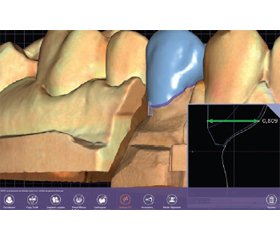Oral and General Health Том 4, №2, 2023
Вернуться к номеру
Застосування оптичних скануючих систем та алгоритмів 3D моделювання як спосіб контролю глибини препарування зубів під незнімні ортопедичні конструкції
Авторы: V. Radchuk (1), N. Hasiuk (1), I. Popovych (2), T. Dzetsiukh (1)
(1) — I. Horbachevsky Ternopil National Medical University, Ternopil, Ukraine
(2) — Poltava State Medical University, Poltava, Ukraine
Рубрики: Стоматология
Разделы: Клинические исследования
Версия для печати
Актуальність. В ортопедичній стоматології на сучасному етапі її розвитку розроблено чимало технік препарування зубів під незнімні конструкції зубних протезів, однак не врахований стан пульпи у відповідь на препарування, внаслідок чого необґрунтованою є лікарська тактика щодо збереження чи екстирпації пульпи опорних зубів залежно від клінічного випадку. З огляду на загальноприйняті правила препарування зубів під незнімні ортопедичні конструкції існує значний відсоток ускладнень. Контроль глибини одонтопрепарування дає можливість провести цю маніпуляцію максимально раціонально та забезпечує ефективність протезування, виходячи зі стану вітальності препарованих зубів. Метa дослідження: визначення та контроль глибини препарування досліджуваних зубів із застосуванням техніки цифрового об’ємного сканування й алгоритмів цифрового графічного 3D редактора в системі CAD/CAM. Матеріали та методи. У статті наведено результати використання цифрового об’ємного сканування системи CAD/CAM та інтегрований алгоритм цифрового 3D моделювання для визначення та контролю глибини препарування зубів під незнімні ортопедичні конструкції. Результати. За результатами цифрового об’ємного сканування визначено робочу товщину одонтопрепарування в ділянці шийки зуба із формуванням різних видів шамфера в різних групах дослідження. Для визначення глибини препарування твердих тканин зуба було змодельовано штучну коронку в системі CAD — на цифровому об’ємному сканері NeWay (Open Technologies) та отримано дані про її товщину в ділянці уступу. Висновки. Метод цифрового об’ємного сканування для визначення та контролю глибини препарування твердих тканин зубів дає можливість запобігтити розвитку необоротних морфофункціональних змін в тканинах зубів, спричинених одонтопрепаруванням.
Background. In orthopedic dentistry at the present stage of its development, a chemical technique for preparing teeth for fixed structures of dentures has been developed; however, the state of the pulp in response to preparation is not taken into account. As a result, medical tactics for preserving or extirpating the pulp of abutment teeth, depending on the clinical case, are unreasonable. Given the generally accepted rules for preparing teeth for fixed orthopedic structures, there is a significant percentage of complications. Controlling the depth of tooth preparation makes it possible to carry out this manipulation as rationally as possible, and as a result to ensure the effectiveness of procedure, based on the state of vitality of the prepared teeth. The aim of the study is to determine and control the depth of the studied teeth preparation using digital volumetric scanning technology and algorithms of a digital graphic 3D editor in the CAD/CAM system. Materials and methods. The article presents the results of using digital volumetric scanning of the CAD/CAM system and an integrated algorithm for digital 3D modeling to determine and control the depth of teeth preparation for fixed orthopedic structures. Results. Based on the results of digital volumetric scanning, the working thickness of the tooth preparation in the area of the tooth neck was determined with the formation of various types of chamfer in different study groups. In order to determine the depth of the preparation of hard dental tissues, an artificial crown was modeled in the CAD system — digital volumetric scanner NeWay (Open Technologies) and data on its thickness in the area of the ledge were obtained. Conclusions. Method of digital volumetric scanning to determine and control the depth of preparation of hard dental tissues makes it possible to prevent the development of irreversible morpho-functional changes in the tissues of teeth caused by odontoreparation.
незнімне протезування зубів; CAD/CAM; шамфер; пришийковий уступ; штучна коронка
fixed dental prosthetics; CAD/CAM; chamfer; cervical ledge; artificial crown

